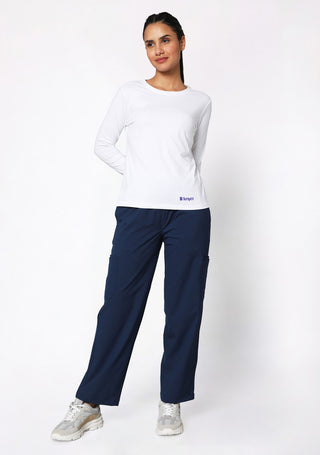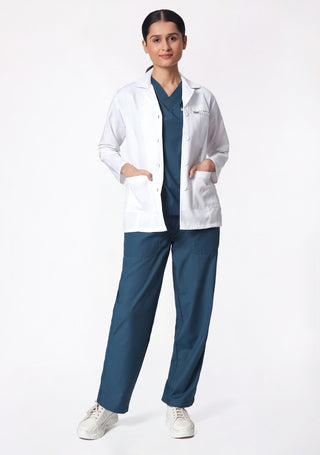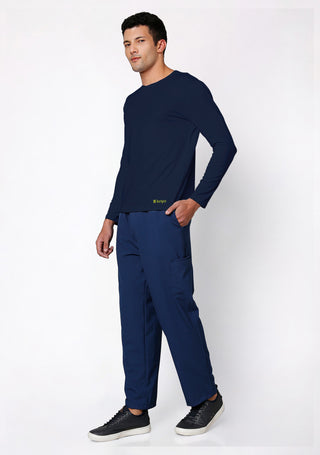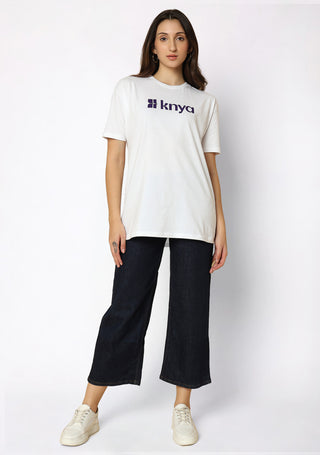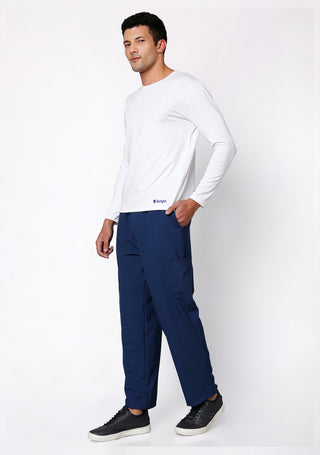To look more polished as an NP without spending too much was always a dream , but now all you have to do is to build a capsule wardrobe with interchangeable pieces in neutral colors.Choose wrinkle-resistant fabrics, maintain clean shoes, and keep accessories minimal. Ironing your clothes, maintaining good grooming, and wearing a name badge neatly can go a long way without extra cost.
Understand the Dress Code Policy
Before investing in new work attire, knowing the right rules helps you make informed choices and avoid unnecessary wardrobe mishaps. Familiarize yourself with your employer's dress code policy. Healthcare settings clinics, hospitals, private practices, or urgent care centers may have different rules about colors, uniform types, accessories, and even hairstyles.
-
Embroidered name tags or lab coats are required
-
Open-toe shoes are prohibited
-
Specific colors or brands are preferred
-
Tattoos and piercings need to be covered
Ready to explore our amazing scrubs collection? Browse the best here
Scrubs: Practical, Professional, and Presentable
For many nurse practitioners the most practical attire for their busy day will be scrubs, It's their go-to daily wear. But not all scrubs are created equal.
Fabric & Fit:
Choose scrubs made from performance blends like polyester-rayon-spandex for flexibility and breathability. A tailored but not tight fit looks polished and ensures ease of movement. Avoid overly baggy or clingy scrubs as they can appear unkempt or inappropriate.
Color:
Neutral or solid colors such as navy blue, charcoal, black, or hunter green often convey professionalism. Brighter colors and patterns might be allowed in pediatrics or casual clinics but should be avoided in more formal settings unless permitted.
Maintenance:
Always wear clean, wrinkle-free scrubs. Dirty or faded scrubs reflect poorly on your hygiene and attention to detail. Having multiple pairs ensures you're always prepared, especially during long or overnight shifts.
Lab Coats
It's always a symbol of authority. A well-fitting white lab coat immediately distinguishes a Nursing Professional from other staff and is often associated with credibility and leadership.
Length:
For nurse practitioners, a knee-length or mid-thigh white coat is typically appropriate. Longer coats are usually reserved for physicians, while short coats may appear more junior.
Customization:
Personalize your coat with your name and credentials embroidered clearly. Consider adding your department or area of specialty. Subtle monogramming can also add a refined touch without appearing flashy.
Fabric & Cleanliness:
Choose a coat made from wrinkle-resistant, stain-repellent fabric. White coats tend to get soiled easily, so keep them pristine. Keep a spare in your locker or office, just in case.
We believe you deserve the best. Shop our amazing selection of lab coats right here.
Business Casual Alternatives
Should avoid jeans, graphic tees, crop tops, leggings, and other casual wear. In some outpatient settings, NPs are allowed to wear business casual clothing with or without a white coat.
For Women:
-
Tops: Blouses, turtlenecks, or solid-colored tops with modest necklines.
-
Bottoms: Slacks, ankle-length trousers, or knee-length skirts.
-
Shoes: Closed-toe flats or professional low-heeled shoes. Avoid sandals or stilettos.
For Men:
-
Shirts: Collared shirts, polo shirts, or sweaters over a button-down.
-
Pants: Chinos or dress pants in neutral tones.
-
Shoes: Loafers or leather shoes avoid sneakers unless the workplace is casual.
Footwear: Where Comfort Meets Safety
The footwear you choose should not only match with your outfit but also it should provide comfort and safety. Nurse practitioners are on their feet for hours, moving quickly through hallways, exam rooms, and nurses' stations.
Key Features:
-
Closed-toe: For safety and infection control
-
Non-slip sole: To prevent falls on polished hospital floors
-
Arch support: To reduce fatigue and foot strain
-
Easy to clean: Leather, rubber, or synthetic materials are ideal
Recommended Styles:
-
Clogs (like Dansko or Sanita)
-
Athletic-style nursing shoes (like Skechers Work or Hoka One One)
-
Slip-resistant professional flats
Accessories and Grooming:
Accessories can enhance your appearance but should be minimal and practical in a hospital environment. Always remember less is more.
Jewelry:
-
Wear simple studs or small hoops.
-
Avoid dangling earrings, large rings, or heavy bracelets.
-
Wedding bands are fine, but multiple rings can interfere with gloves or hygiene.
Hair:
-
Keep hair neat and away from the face.
-
Long hair should be tied back.
-
Use minimal hair accessories in neutral tones.
Makeup and Fragrance:
-
Keep makeup natural and fresh.
-
Avoid heavy perfume or cologne—many patients are sensitive to scent.
Nails:
-
Keep nails short and clean.
-
Avoid long acrylics or elaborate nail art, which can harbor bacteria and interfere with glove use.
Climate and Cultural Sensitivity
Dressing by being aware of your environment can always help you work more comfortably.If you're in a region with cultural expectations or conservative dress norms, ensure your attire is respectful and modest.Layering properly is also crucial hospital interiors can be cold, so having a thermal undershirt, vest, or a fleece-lined scrub jacket can help you stay warm without compromising your professional appearance.
Create a Capsule Wardrobe
Opening your wardrobe each morning and thinking about what to wear especially as a nurse practitioner is a time consuming process.The whole idea of building a capsule wardrobe is to avoid these long decision making processes. Maintaining a laundry routine along with it ensures your clothes are always fresh and ready.
Your capsule might include:
-
4–5 pairs of scrub sets
-
2–3 white lab coats
-
2 business casual outfits
-
2 pairs of work shoes
-
Basic layering pieces (undershirts, socks, cardigans)
Maintaining a laundry routine ensures your clothes are always fresh and ready.




